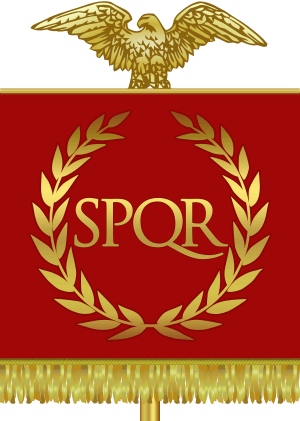SPQR facts for kids

SPQR stands for a Latin phrase: Senātus Populusque Rōmānus. This means "The Senate and People of Rome." It was a very important symbol for the ancient Roman Republic. Even today, it's still used as an official symbol for the city of Rome.
You could see SPQR everywhere in ancient Rome! It was on Roman coins, carved into stone or metal on public documents, and on monuments and public buildings. It was also proudly displayed on the flags (vexilloids) carried by the Roman legions, who were Rome's powerful armies.
This famous phrase also appeared in many Roman writings. Important speakers like Cicero used it in their speeches. It was also in famous history books, such as Ab Urbe Condita Libri ("Books from the Founding of the City") by Livy. These books tell us a lot about Rome's history.
When Was SPQR First Used?
We don't know exactly when SPQR was first used. It started appearing on inscriptions around 80 BC. This was during the later part of the Roman Republic. It continued to be used for a long time. The last time it appeared on coins was during the rule of Constantine the Great. He was emperor from AD 312 to 337 and was the first Christian Roman emperor.
SPQR in the Roman Empire
Even after the Roman Republic became the Roman Empire, the SPQR symbol was still used. The emperors were seen as representing the people of Rome. However, the Senate's decisions were often guided by what the emperor wanted.
Later on, some modern leaders also used similar ideas. For example, during the time of Benito Mussolini in Italy, SPQR was put on many public buildings. Mussolini wanted to make his rule seem like a "New Roman Empire."
Images for kids
-
The inscription on the Arch of Titus
-
Manhole cover in Rome with SPQR inscription
-
SPQR in the coat of arms of Reggio Emilia
-
Detail from the mosaic floor in the Galleria Vittorio Emanuele II in Milan
-
"Superiority of the warrior class", by Wenceslaus Hollar
-
Arch of Septimius Severus top inscription
-
Dedicatory plaque to Federico Fellini on Via Veneto
See also
 In Spanish: SPQR para niños
In Spanish: SPQR para niños










